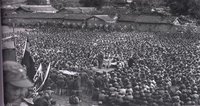Long March
|
|
- Alternative meaning: Long March rocket
Long_march.png
Long March
The Long March (長征, pinyin:Chángzhēng) was a massive military retreat undertaken by the Chinese Communist Army to evade the pursuit of the Kuomintang army. The Communist Army of the Chinese Soviet Republic, led by Mao Zedong and Zhou Enlai, was on the brink of complete annihilation by Chiang Kai-Shek's troops in Jiangxi Province in October 1934. The communists escaped in circling retreat to the north, which ultimately covered some 8,000 km (4,960 miles) over 370 days. The route branched through some of the most difficult terrain of western China and arrived 9,600 km (5,952 miles) west, then north, to Shaanxi. (In 2003, Ed Jocelyn and Andrew McEwen[1] (http://www.newlongmarchers.com) retraced the route in 384 days[2] (http://www.chinadaily.com.cn/en/doc/2003-11/23/content_283948.htm) and estimated it was actually about 6,000 km (3,700 miles) long.[3] (http://www.taipeitimes.com/News/front/archives/2003/11/06/2003074739))
| Contents |
Beginnings of the retreat
In 1934, the Communist Army established itself in Jiangxi, which was a bastion of communism. However, they were completely surrounded and besieged by the Kuomintang. The Communist Army decided that a strategic retreat would be the best way to avoid annihilation.
The first movements of the retreat were undertaken by He Long, Xiao Ke, Xu Xiangqian and Fang Zhimin. Fang Zhimin was first to break through Kuomintang lines in June, followed by Xiao Ke in August.
Despite the importance of these troop movements, they were actually a diversion to allow the retreat of more important leaders from Jiangxi. Thus in October, the 130,000 troops under Mao Zedong and Zhu De broke through a line of 400,000 Kuomintang soldiers.
The rise of Mao
After several months of marching westward, harassed by the Kuomintang, the Communist Army was exhausted. Under these conditions, the Communists met in Zunyi in Guizhou province January 6–8, 1935. Here, they decided the future of the leadership of the communist party. On January 15, at Zunyi, the meeting which decided the future leadership of the party began. It lasted for three days. The generals of the Red Army and the old guards of the leadership sided with Mao and he was elevated to the position of Party Secretary. This gave him great power within the Communist Party of China (CCP). In addition to that, he replaced Zhou Enlai as the Director of Military Affairs Commision. As a result, by the time they left Zunyi on January 19, 1935, Mao was the dominant figure in the party.
When the Red Army resumed its march north, they found the direct route to Sichuan blocked by Chiang's forces. Mao now aimed to travel north to join Zhang Guotao's Fourth Front Army. However, Chiang easily determined what Mao had planned and moved to stop him. A brilliant series of tactical manoeuvres in Ghuizou enabled Mao to break out to the north and cross the Yangtze on May 8. He had now being on move for seven months since leaving Jiangxi and had only 25,000 men left.
The Communists decided to head for Shaanxi Province, although the decision was not unanimous. Leaders like Zhang Guotao preferred to establish themselves near the Soviet border. However, Mao had the last word.
The Communist Army then penetrated into areas populated by non-Chinese who were very hostile to Chinese encroachment. Under these circumstances, they were not only harassed by the Kuomintang, but also ambushed by local warlords allied with the Guomingdang as well as tribes hostile to all Chinese. The terrain was also a large factor: the Communists had to cross mountains, rivers and bridges all while fighting against hostile warlords. The incident at Luding Bridge embodies the struggle during the Long March.
In July, the troops under Mao united with the army from the fourth front, which was coming from Henan. After some dissension over the direction in which the troops should move, they split. Mao's troops then traversed several swamps and suffered several ambushes from the Tibetans and the Hui.
Finally in October, the army reached Shaanxi.
All along the way, the Communist Army confiscated property and weapons from local warlords and landlords, while recruiting peasants and the poor. Nevertheless, only some 20,000 out of about 90,000 soldiers who had started the march ultimately made it to the final destination of Yan'an in 1935. A variety of setbacks contributed to the loss including fatigue, hunger, coldness, sickness, desertion, and military losses. Because of defeats, membership in the party was also reduced from 300,000 to around 40,000. (Moise 79)
Conclusion
While costly, the Long March gave the Communist Party of China the isolation it needed, allowing its army to recuperate and rebuild in the north of China. It also was vital in helping the CCP gain a massive positive reputation among the peasants, especially due to the determination and dedication of the surviving participants of the Long March. This is epitomized in the policy ordered by Mao for all soldiers to follow the Eight Points of Attention, the main spirit of which being not to harm the peasants in any way or to show them disrespect, despite tempting situations, such as forcible confiscation of food in order to feed themselves. This was probably responsible for winning them most of their followers.
Following the end of World War II, the Communist Army, a.k.a. Eighth Route Army (and later People's Liberation Army), returned to drive the Kuomintang out of Mainland China to the island of Taiwan. Upon the establishment of the People's Republic of China, the Long March has since been glorified as the party's symbol for strength and resilience.
The Long March was also a significant event in solidifying Mao's role as the undisputed leader of the CCP. Many participants of the March also went on to become prominent party leaders including Liu Shaoqi, Zhu De, Lin Biao and Deng Xiaoping.
External links
- map of primary route (http://users.erols.com/mwhite28/longmarc.htm)de:Langer Marsch

